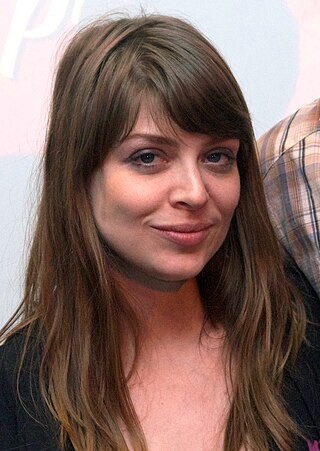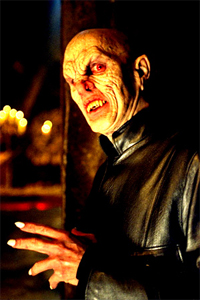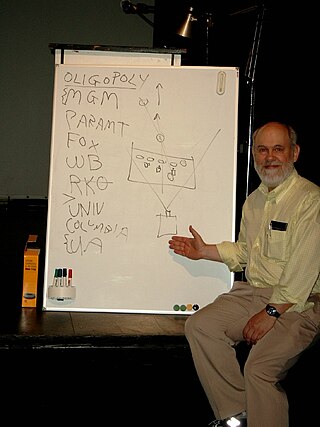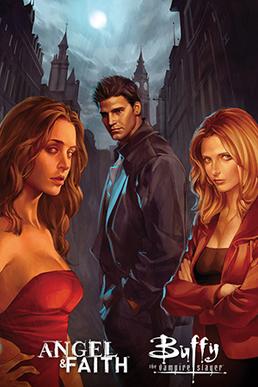Related Research Articles

Buffy the Vampire Slayer is a 1992 American comedy vampire film directed by Fran Rubel Kuzui and written by Joss Whedon. It stars Kristy Swanson as the eponymous Buffy Summers, a Valley Girl cheerleader who learns it is her fate to hunt vampires. Donald Sutherland, Paul Reubens, Rutger Hauer, and Luke Perry appear in supporting roles.

Sergei Mikhailovich Eisenstein was a Soviet film director, screenwriter, film editor and film theorist. He was a pioneer in the theory and practice of montage. He is noted in particular for his silent films Strike (1925), Battleship Potemkin (1925) and October (1928), as well as the historical epics Alexander Nevsky (1938) and Ivan the Terrible. In its 2012 decennial poll, the magazine Sight & Sound named his Battleship Potemkin the 11th-greatest film of all time.

Buffy Anne Summers is the title character of the Buffy the Vampire Slayer franchise. She first appeared in the 1992 film Buffy the Vampire Slayer before going on to appear in The WB/UPN 1997–2003 television series and subsequent 1998–2018 Dark Horse and 2019–present Boom! Studios comic series of the same name. The character has also appeared in the spin-off series Angel, as well as numerous expanded universe materials such as novels and video games. Buffy was portrayed by Kristy Swanson in the film and by Sarah Michelle Gellar in the television series. Giselle Loren has lent her voice to the character in both the Buffy video games and an unproduced animated series, while Kelly Albanese lent her voice to the character in the Buffy the Vampire Slayer Season Eight motion comics.

Buffy the Vampire Slayer is an American supernatural drama television series created by writer and director Joss Whedon. The concept is based on the 1992 film, also written by Whedon, although they are separate and unrelated productions. Whedon served as executive producer and showrunner of the series under his production tag Mutant Enemy Productions. It premiered on March 10, 1997, on The WB and concluded on May 20, 2003, on UPN.

Amber Benson is an American actress, writer, director, and producer. She is best known for her role as Tara Maclay on the TV series Buffy the Vampire Slayer (1999–2002), and has also directed, produced and starred in her own films Chance (2002) and Lovers, Liars & Lunatics (2006). She also starred in the movie Kiss the Bride (2007). She co-directed the film Drones (2010) with fellow Buffy cast member Adam Busch. Benson also starred as a waitress in the horror movie The Killing Jar (2010).

The Master is a fictional character on the action-horror/fantasy television series Buffy the Vampire Slayer (1997–2003). He is a centuries-old vampire portrayed by Mark Metcalf, determined to open the portal to hell below Sunnydale High School in the fictional town of Sunnydale where the main character Buffy Summers lives. The premise of the series is that Buffy is a Slayer, a teenage girl endowed with superhuman strength and other powers, which she uses to kill vampires and other evil beings. Each season of the series Buffy and the small group of family and friends who work with her, nicknamed the Scooby Gang, must defeat an evil force referred to as the Big Bad; the villain is usually trying to bring on an apocalypse. The Master is the first season's Big Bad.

Big Bad is a term to describe a major recurring adversary, usually the chief villain or antagonist in a particular broadcast season, originally used by the Buffy the Vampire Slayer television series. It has since been used to describe annual villains in other television series, and has also been used in scholarly work discussing Buffy the Vampire Slayer.

Kristine Sutherland is an American actress best known for her starring role as Buffy Summers' mother Joyce Summers on the television series Buffy the Vampire Slayer, where she appeared in every season (1997–2003), and her role as Mae Thompson in Honey, I Shrunk the Kids (1989).

Vampire films have been a staple in world cinema since the era of silent films, so much so that the depiction of vampires in popular culture is strongly based upon their depiction in films throughout the years. The most popular cinematic adaptation of vampire fiction has been from Bram Stoker's 1897 novel Dracula, with over 170 versions to date. Running a distant second are adaptations of the 1872 novel Carmilla by Sheridan Le Fanu. By 2005, the Dracula character had been the subject of more films than any other fictional character except Sherlock Holmes.

Classical Hollywood cinema is a term used in film criticism to describe both a narrative and visual style of filmmaking that first developed in the 1910s to 1920s during the later years of the silent film era. It then became characteristic of American cinema during the Golden Age of Hollywood, between roughly 1927 and 1960. It eventually became the most powerful and pervasive style of filmmaking worldwide.

David Jay Bordwell was an American film theorist and film historian. After receiving his PhD from the University of Iowa in 1973, he wrote more than fifteen volumes on the subject of cinema including Narration in the Fiction Film (1985), Ozu and the Poetics of Cinema (1988), Making Meaning (1989), and On the History of Film Style (1997).
Buffy studies, also called Buffyology, is the study of Joss Whedon's popular television series Buffy the Vampire Slayer and, to a lesser extent, its spin-off program Angel. It explores issues related to gender, family, ethics and other philosophical issues as expressed through the content of these shows in the fictional Buffyverse.

Hallelujah is a 1929 American pre-Code Metro-Goldwyn-Mayer musical directed by King Vidor, and starring Daniel L. Haynes and Nina Mae McKinney.
"Welcome to the Hellmouth" is the series premiere of the American supernatural drama television series Buffy the Vampire Slayer. It originally aired on The WB on March 10, 1997 in a two-hour premiere along with the following episode, "The Harvest". The episode was written by the series creator and executive producer Joss Whedon and directed by Charles Martin Smith. "Welcome to the Hellmouth" received a Nielsen rating of 3.4 upon its original airing and received largely positive reviews from critics.

Buffy the Vampire Slayer Season Eight is a comic book series published by Dark Horse Comics from 2007 to 2011. The series serves as a canonical continuation of the television series Buffy the Vampire Slayer, and follows the events of that show's final televised season. It is produced by Joss Whedon, who wrote or co-wrote three of the series arcs and several one-shot stories. The series was followed by Season Nine in 2011.
Quality television is a term used by television scholars, television critics, and broadcasting advocacy groups to describe a genre or style of television programming that they argue is of higher quality due to its subject matter, style, or content. For several decades after World War II, television that was deemed to be "quality television" was mostly associated with government-funded public television networks; however, with the development of cable TV network specialty channels in the 1980s and 1990s, US cable channels such as HBO made a number of television shows during the turn of the century that some television critics argued were "quality television", such as Angels in America, Sex and the City, The Sopranos, The Wire and Six Feet Under.
An auteur is an artist with a distinctive approach, usually a film director whose filmmaking control is so unbounded and personal that the director is likened to the "author" of the film, thus manifesting the director's unique style or thematic focus. As an unnamed value, auteurism originated in French film criticism of the late 1940s, and derives from the critical approach of André Bazin and Alexandre Astruc, whereas American critic Andrew Sarris in 1962 called it auteur theory. Yet the concept first appeared in French in 1955 when director François Truffaut termed it policy of the authors, and interpreted the films of some directors, like Alfred Hitchcock, as a body revealing recurring themes and preoccupations.
Janet Staiger is the William P. Hobby Centennial Professor Emeritus of Communication in the Department of Radio-Television-Film and Professor Emeritus of Women's and Gender Studies at the University of Texas at Austin.

Buffy the Vampire Slayer Season Nine is a comic book series published by Dark Horse Comics from 2011 to 2013. It is the sequel to the Season Eight comic book series, a canonical continuation of the television series Buffy the Vampire Slayer. The Season Nine brand also incorporates a new Buffy spin-off series, Angel & Faith, and two spin-off miniseries Willow: Wonderland and Spike: A Dark Place. The core series consisted of 25 issues and each miniseries consisted of 5 issues.

The first season of the American supernatural drama television series Buffy the Vampire Slayer originally aired between March 10 and June 2, 1997, on The WB. Conceived as a mid-season replacement, the season consists of twelve episodes, each running approximately 45 minutes in length, and originally aired on Mondays at 9:00 pm ET.
References
- ↑ David Bordwell's website
- ↑ Thompson, Kristin (1981). Eisenstein's Ivan the Terrible: A Neoformalist Analysis . Princeton University Press. ISBN 978-0-691-06472-7..
- ↑ Thompson, Kristin (1988). Breaking the Glass Armor. Princeton University Press..
- ↑ Cited in the Wilcox and Lavery article on Buffy the Vampire Slayer . Available at: https://web.archive.org/web/20061010121452/http://davidlavery.net/Essays/50_Key_Buffy.pdf
- 1 2 King, Geoff (2002-03-29). New Hollywood Cinema: An Introduction. I B Tauris & Co. ISBN 1-86064-750-2.
- ↑ Kristin Thompson. Storytelling in Film and Television. Summary available at: http://209.85.165.104/search?q=cache:_gjqtGL44gEJ:www.hup.harvard.edu/catalog/THOSTF.html+%22art+television%22&hl=en&ct=clnk&cd=126
- ↑ Thompson, Kristin (2007). The Frodo Franchise. Penguin Books. paperback: ISBN 978-0-14-300749-4
- ↑ Thompson, Kristin (September 5, 2006). "Observations on film art. About Kristin Thompson". davidbordwell.net. Retrieved 27 December 2012.